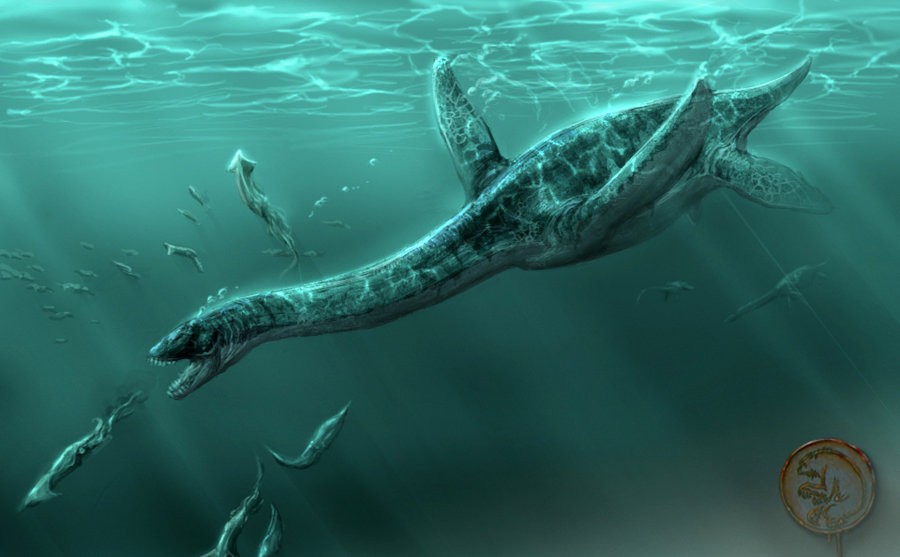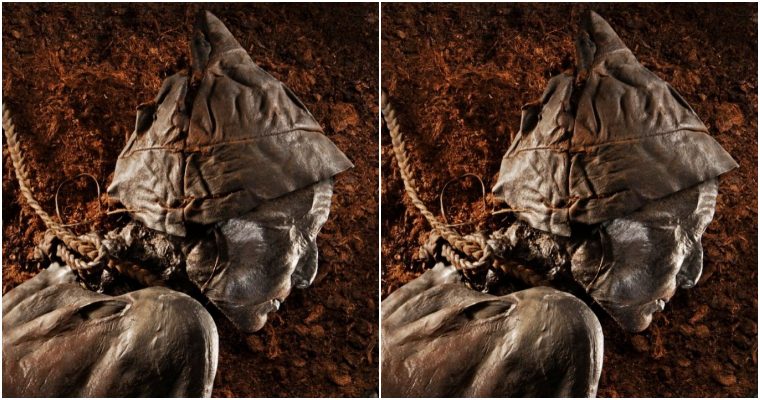Study provides more proof that freshwater plesiosaurs existed. However, they vanished before Loch Ness was created.

An illustration of a leptocleidid plesiosaur, right, under attack by a spinosaurus dinosaur. (Andrey Atuchin)
Some massive, carnivorous reptiles from the age of the dinosaur likely lived in rivers and lakes, new research suggests — but that doesn’t mean the Loch Ness monster is a plesiosaur.
A new paper published in the journal Cretaceous Research adds to existing evidence that plesiosaurs — which are broadly known as ocean dwellers — were also capable of living in freshwater.
That’s proved to be an exciting bit of news for Nessie believers, as one of the most common explanations for the fabled Scottish sea monster is that she is, in fact, a plesiosaur.
But when asked whether his research lends credibility to that theory, co-author Nick Longrich said: “Not really.”
“Could a plesiosaur exist in freshwater? Yeah. Other aspects of the scenario just don’t work,” Longrich, a University of Bath paleontologist and evolutionary biologist, told As It Happens guest host Paul Hunter.
Plesiosaurs went extinct with the dinosaurs
The most obvious reason is that plesiosaurs went extinct 66 million years ago, when the Loch Ness — an inlet in the Scottish Highlands after which the creature is named — was nothing but ice and glaciers.
What’s more, with a surface area 56 square kilometres, the Loch Ness is simply too small to accommodate a viable population of plesiosaurus, which ranged in size from 4.5 to 15 metres, depending on the species.
“You never know anything for certain,” Longrich said. “But for all intents and purposes, it’s extremely unlikely — if not impossible — a Loch Ness monster exists, and it’s a plesiosaur.”

From left to right, a plesiosaur humerus, vertebrae and tooth. (Nick Longrich)
Longrich’s research begins not in a lab, but in a shop in Morocco that sells things like rocks, polished limestone and ammonite fossils.
“They had a little room in the back with a few bones. And, you know, I looked at one of these things and said, ‘Well, that’s a plesiosaur.'”
The bone was a 1.5-metre arm from a baby leptocleididae, one of the smaller species of plesiosaur. It was unearthed from a 100-million-year-old freshwater river system in what is now the Sahara desert.
Intrigued, he bought it and brought it back to Britain for further study.
Then he — along with colleagues from the University of Portsmouth in the U.K. and Université Hassan II in Morocco — went about looking for other leptocleididae fossils that originated in Morocco’s freshwater systems, and ended up with several, including teeth, vertebrae, and a humerus.
“It turns out they’re fairly common in freshwater,” Longrich said.
Not the 1st evidence of freshwater plesiosaurs
The findings were not surprising to Don Henderson, a dinosaur and marine reptile expert from the Royal Tyrrell Museum in Drumheller, Alta.
“It’s not news,” he said. “We’ve known about freshwater plesiosaurs from Western Canada since 1902.”
It’s been more than a century, Henderson said, since members of the Geological Survey of Canada first uncovered plesiosaur fossils in Alberta’s Red Deer River valley, in what is now known as Dinosaur Provincial Park. Remnants of the ancient marine reptiles have also been found in freshwater locations in South Australia, Britain and Australia, he said.
Usually, he says, the freshwater fossils belong to juveniles, which suggests the creatures may have hidden away from ocean predators when they were young, before setting off to sea as adults.
“It’s just a safer environment,” he said. “Although, they would have had to dodge crocodiles.”
Nick Longrich is a University of Bath paleontologist and evolutionary biologist. (Submitted by Nick Longrich)
There’s also plenty of precedent in nature. Beluga whales and Irrawaddy dolphins can move between freshwater and saltwater. And river dolphins have evolved to live full time in freshwater.
“The whole time there was dinosaurs on land, there was plesiosaurs in the world’s seas and oceans,” Henderson said. “It’s reasonable to think that in that huge amount of time, 160 million years, that some of them are going to move into freshwater.”
Longrich acknowledges these findings aren’t novel. But the volume of fossils the team was able to collect suggests that leptocleididae were not only able to tolerate freshwater, but maybe even lived there full-time.
“It shows [plesiosaurs] were, you know, a very widespread, adaptable, opportunistic group and really successful around for over 100 million years. And they exploit a huge range of ecosystems,” he said.
So where does Nessie come in?
That, in and of itself, is science worth talking about, Longrich says. But most of the headlines about his work focus — including, admittedly, this one — focus on the Loch Ness monster.
That’s likely because the University of Bath press release about the findings very briefly mentioned the legendary creature, noting: “But what does this all mean for the Loch Ness monster? On one level, it’s plausible.”
Several U.K. media outlets latched onto that line, with headlines like “Existence Of Loch Ness Monster ‘Plausible’ After Discovery of Fossils in North Africa” or “Loch Ness Monster Bombshell: Creature’s Existence ‘Plausible’ After Major Fossil Discovery.”

Nessie fans have also weighed in. One Loch Ness boat tour guide told the New York Times the findings gives him hope that “anything is possible,” while a self-described “monster hunter” insisted if there were plesiosaurs in the Loch Ness, he would have seen one by now.
Longrich says the whole thing has left him with “mixed feelings.”
“Part of me is like, I’m trying to be a serious scientist and I’m getting wrapped up in cryptozoology and pseudoscience. But on the other hand, you know, I think it’s sort of harmless fun,” he said.
“I guess what I’d say is that, you know, we know less than we think we do. We tend to be overconfident in what we know, but we keep finding surprising things out there. And that’s why we do science. If we knew everything and we were never going to be surprised, there would be no point.”







